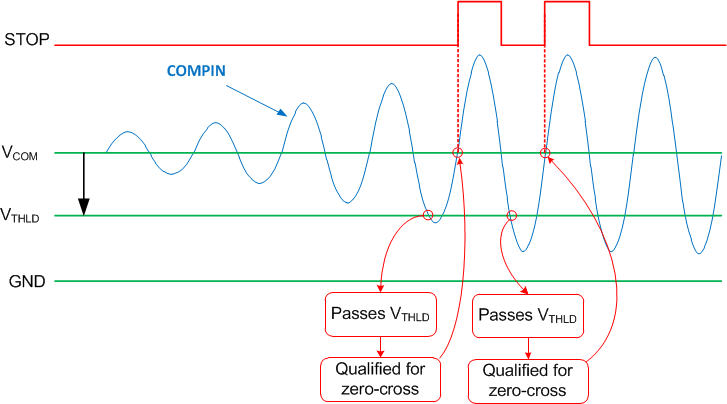SNAS854 February 2023 TDC1000-Q1
PRODUCTION DATA
- 1 Features
- 2 Applications
- 3 Description
- 4 Revision History
- 5 Pin Configuration and Functions
- 6 Specifications
- 7 Parameter Measurement Information
-
8 Detailed Description
- 8.1 Overview
- 8.2 Functional Block Diagram
- 8.3 Feature Description
- 8.4 Device Functional Modes
- 8.5 Programming
- 8.6 Register Maps
- 9 Application and Implementation
- 10Device and Documentation Support
- 11Mechanical, Packaging, and Orderable Information
8.3.6.3 Event Manager
The event manager is a digital state machine in the STOP pulse generation circuit of the TDC1000-Q1. The event manager controls the maximum number of STOP pulses to generate on the STOP pin and the receive mode for the STOP pulse generation. The number of STOP pulses is configured in the NUM_RX field in the CONFIG_1 register. The receive mode is selected in the RECEIVE_MODE bit of the CONFIG_4 register. See sections GUID-2034B423-2789-4CE3-9084-D9E69B654791.html#TITLE-SNAS648SNAS6489609 and GUID-04507CCD-73B6-4DAC-96E4-9F68454CABBC.html#TITLE-SNAS648SNAS6484838 for details about the receiver modes of the TDC1000-Q1.
#SNAS648960 shows an example for NUM_RX = 2h and RECEIVE_MODE = 0. When the echo signal amplitude exceeds values smaller than VTHLD, the threshold detect comparator indicates to the event manager to qualify the next zero-cross event as valid. When the qualified zero-cross is detected by the zero-cross detect comparator, the event manager passes the pulse to the STOP pin until the number of receive events programmed in NUM_RX is reached.
 Figure 8-8 Signal Qualification, Zero-Cross Detection and STOP Pulse Generation
Figure 8-8 Signal Qualification, Zero-Cross Detection and STOP Pulse Generation